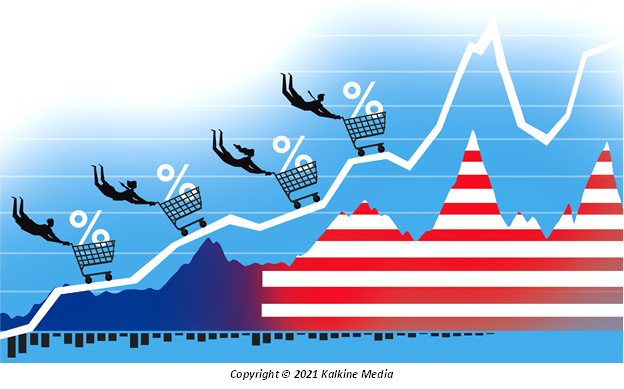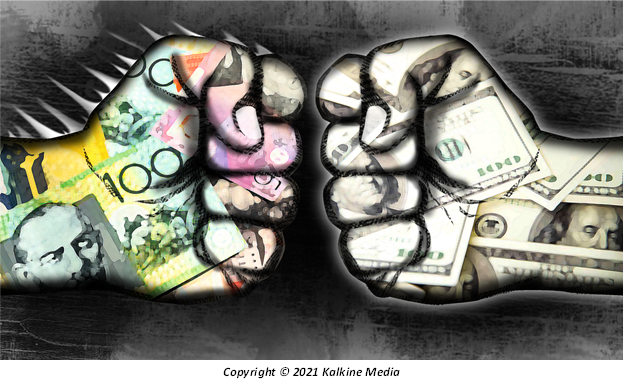Summary
- Inflation concerns are heightened when an economy is in recovery mode due to a greater money supply in the economy.
- Indicators like reduced unemployment, high economic growth after a prolonged period of slowdown and record-high price increases in commodities are signs of incoming inflation.
- With large fiscal stimulus and favourable monetary policy in the backdrop, some countries like the US are on the brink of an inflationary spell.
Inflations concerns among investors and experts have taken shape over the past few months. Fears are mounting that a strong post-COVID recovery could spur consumer spending and a resultant price increase in economies, like the US.
At a time when inflation seems to be on its accelerating path, some economic indicators hinting towards increasing inflationary pressures demand closer attention. Some of these indicators include rising employment levels, increased economic growth after a period of slowdown and, of course, a short-term rise in commodity prices. Even short-run inflation can be the sign of an impending price rally in the long run.
DO NOT MISS: Can inflation woes spark a firestorm in global markets?

Inflationary fears are generally heightened when an economy is emerging out of a recessionary phase. During such a time, it is expected that industries would not immediately have the capacity to fulfil demand after an economic slump. Thus, most industries become incapacitated and fail to meet market demand. This could mean a supply shortage, which ultimately fuels inflation. That is why, inflation expectations are objectively high when an economy is in a recovery phase. In addition, massive government stimulus, which is often provided after an economic slowdown, points towards the onset of a price rally.
Here is a look at five key reasons why growing inflation anxiety is a reason to worry:
Risk of Currency Depreciation
High inflation could mean a fall in the exchange rate when the domestic currency is undergoing inflation. When a country experiences inflation, the domestic currency loses value against foreign currencies.
If the currency losing value belongs to the importer nation, the partner country or the exporter earns more for the same amount of goods exported due to the fall in the value of the importing country’s money.

At the same time, the country experiencing inflation suffer a loss in its exports too. Consider the case of Australia and its iron ore exports. Once inflation sets in, the amount of money received from its trading partner when converted to AUD would fetch lesser returns than before. Thus, a fall in the AUD/USD rate can be expected in case the inflationary pressures grow in the Australian economy.
Interest Rate May Increase
For central banks, prolonged bouts of inflation could be a good enough reason to act. In such a scenario, central banks usually respond by raising interest rates to discourage borrowing. Raising interest rates de-incentivises loans and reduces the amount of liquidity in the economy. Interest rates are a monetary policy tool that can alter the amount of liquidity in the economy.
The increased cost of borrowing, i.e., increased interest rates, leaving lesser scope for spending in the economy. Instead, saving seems like a better option due to the higher rate offered in such scenario.
In contrast, if interest rates are not reduced, then the pre-existing debt becomes cheaper due to inflation. The real burden of debt seems less because a fixed amount is to be paid in every instalment.
INTERESTING READ: Impact of Inflationary Expectations on Stock Market
Imperils Profitability of Firms
Inflation is usually not a good scenario for industries and manufacturers. Rising prices simply means bigger production spends and higher debt for firms. Inflation may also eat a portion of the profits earned by specific industries operating in the economy.
When producers anticipate a rise in prices, they generally stock up on raw materials. Hoarding of materials can have serious consequences on the economy at a time when consumers are already coping with highly inflated prices. This only increases the cornering of commodities.
Besides, there is a risk that production channels may come to a standstill, as seen during COVID-19 lockdowns, which can take firms much longer than usual to meet the growing demand. This may mean the period for price rise stretching out longer than anticipated. As a result, the hardest-hit sectors offering less wages would see workers leaving their jobs. This may point to a scenario where there is not enough supply of labour even after the effects of the recession have dried down.
Threat of Stagflation
According to the Phillips Curve relation, rising inflation generally means an upswing in employment in an economy. The Phillips Curve equation draws an inverse relationship between unemployment and inflation in an economy.
However, as unemployment falls, employers are expected to pay higher wages to their existing workers. Higher wages are the forerunners of increased liquidity in an economy. With greater wages, consumers have more cash available at their disposal. Increased spending heats the economy and can cast even longer inflation spells than those currently in place.
The situation is even worse in developing nations where economic growth is slow. The state of low economic growth, high unemployment and high inflation give rise to stagflation. Simply put, stagflation is an economic situation wherein inflation remains stagnated for a long period without any economic growth happening. In such a case, productivity also declines.
Impact on Economic Growth
While low to moderate levels of inflation can spur economic growth, a runaway inflation obstructs the growth in an economy.
Government receives greater revenue in the form of higher tax in mild inflationary periods. This could set a perfect ground for greater public spending and influence economic growth. Additionally, internal trade and business can also thrive amidst mild inflation.
Long-term inflation, on the other hand, is an issue of concern. Even with increased government revenue, investment and development projects become expensive and are obstructed by inflated costs. Inflation eats away the value of money and reduces the rate of capital formation, disturbing the pattern of consumption. This can lead to serious shifts in consumer behaviour and slow down economic growth.

.jpg)


